

For more information from Rohn, one of the most well-known tower manufacturers, try their site. Here you will find all of the official data on their towers, which are pretty much the industry standard. I myself have a good deal of Rohn 25(G?) tower.
One bit of advice I'd like to give before going much further is that, as much as I'd trust my life to my tower, I don't know that I'd want it to endure a 24-hour-per-day regime of shaking and vibration. I'd be very careful putting a wind turbine on top of a tower without making sure it's well balanced and easy to stop in case of emergency. Climbing towers in the wind is already no fun, and climbing one to stop a runaway wind turbine might not be the smartest thing you ever did. :-)
Let me first discuss the only special tools that you need to work on towers. The first is a safety belt of some sort. I'm not talking about a rope tied through your belt loops, either, but rather something that you'll be comfortable and confident hanging off of the tower with for long stretches of time. I have my father's tower-climbing belt, and also one from Mike Hales (RIP). I have them specially outfitted with chains and very large spring-loaded hooks. 2 long chains are each about 3 feet long, for going all the way around the tower, and one short one is about half that long, for attaching to tower braces in various situations or for carrying things with. Most tower-climbing belts have only one leather strap that goes around the tower, but you're unprotected when going around guy wires and I like more security than that.
I have seen industrial safety belts at garage sales and stores and they look pretty substantial to me. I'd probably use one myself on a tower, but I'm not necessarily recommending that you do so yourself. Also, remember that climbing to the top of a tower and flipping your belt over the top is surprisingly common and easy to do by mistake, and a good way to die. That's one of the reasons I have the short extra chain on my belt. :-)
The second tool is popularly called a gin pole. This is the device (basically a pipe) which clamps onto an installed tower section and allows you to install one above it (or remove the one above it). It consists of a pipe about as long as one tower section, 2 "clamps", and a pulley. About the only thing special about the pole is, surprisingly, not the pulley, but rather the clamps. The pipe itself can be a nice aluminium pipe, or, as I use, a regular piece of galvanized 1 1/4" water pipe.
The third tool is what I call a "jacker". It's easy to make out of a couple of pieces of flat steel stock about 1" wide and a bolt. Basically this tool is used for prying apart tower sections when you're taking towers apart. The normal way to employ it is to pry at each tower joint, going around all 3 legs while your helper carefully pulls on the rope a bit. Sometimes you can just pry one leg and shake the tower, which is quite a bit faster and can be fairly exciting! :-)
Here are pics of the tools mentioned.
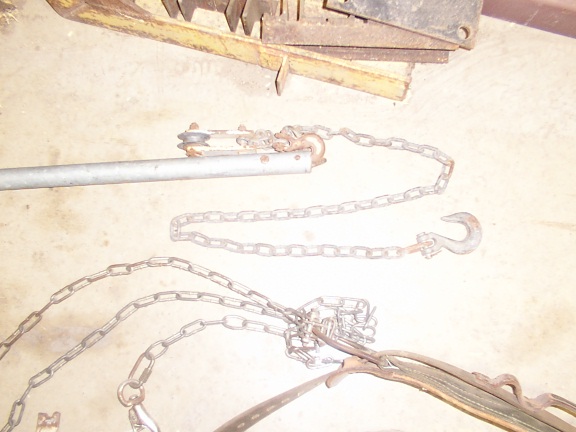

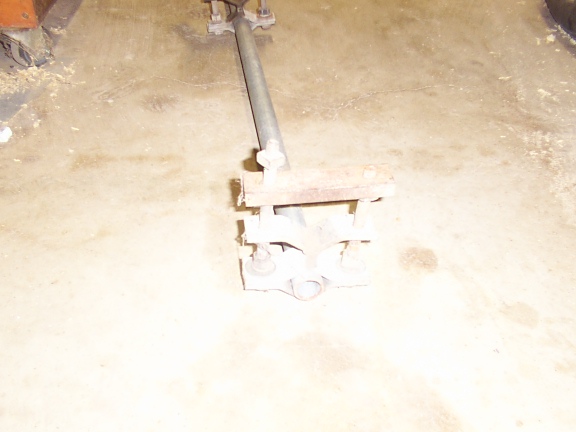
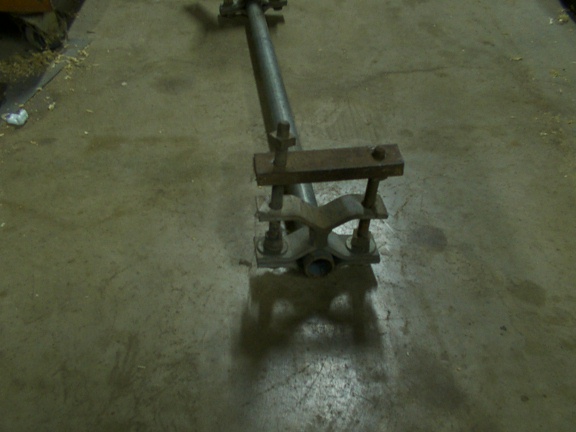

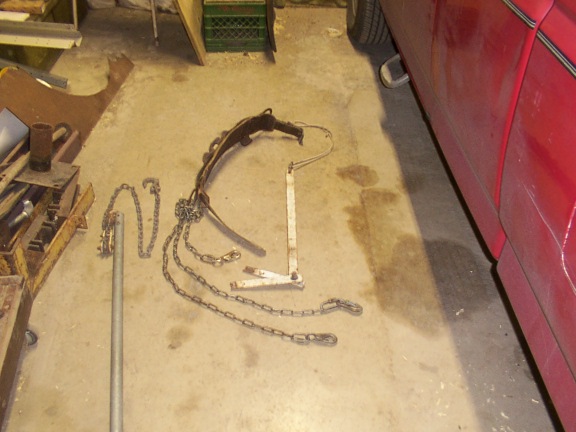

The little pulley at the top of the gin pole doesn't have to be anything very special, but I'd recommend against using cheap steel stamped or tack-welded pulleys. The one I have is an idler pulley off of a Ride King lawnmower, about 2" in diameter (avoid smaller pulleys) with a bearing in the middle ready to accept a 5/16" bolt. To each side of the pulley I have some 3/16" thick flat steel bar, with another bolt at the top. A 5/16" hook is hung into the top of the gin pole, a couple of links of chain run from that to the top bolt in the pulley assembly, and a few more links are run back up and fed into the top of the pole, where a bolt through the pipe holds the chain in.
The idea here is to have a solid pulley with no sharp edges, with enough radius to avoid bending the rope too sharply (which breaks the fibers on the "outside" side of the rope). The pulley should be as close to the top of the pole as practical while still leaving one or two chain links for a bit of swiveling action, which is often useful. With this setup you can also unhook the hook from the top of the pole and hang the gin pole on the tower when necessary.
You need about twice as much rope as your tower is high. Again, tower sections aren't that heavy, so you don't need to break the bank here, but then again, your life is on the line, so buy a reasonable quality of rope and take good care of it (I store mine in a 5-gallon pail). I have black 1/2" nylon rope and it seems to be more than adequate for Rohn 25 towers. INSPECT ALL OF YOUR ROPE BEFORE EACH USE.
The placement of the 2 clamps in the gin pole is important for a reason that's not immediately obvious. Of course you don't want them too close together, as that doesn't give a very strong connection. Having them too far apart, of course, uses up too much of the pole, and we need our pulley to hang at least 1/2 the length of a tower section above the top of the tower.
However, you'll want to install the clamps so that one is at the bottom end of the pole (say 1" away) and the second one is the distance between 2 of the horizontal braces of your particular tower type. The reason? You'll find the the shape of the clamps allows you to wedge both of them into the Vs formed by the tower braces, and this is almost a necessity when working with the pole, especially when raising it above the top of the tower. See this picture:
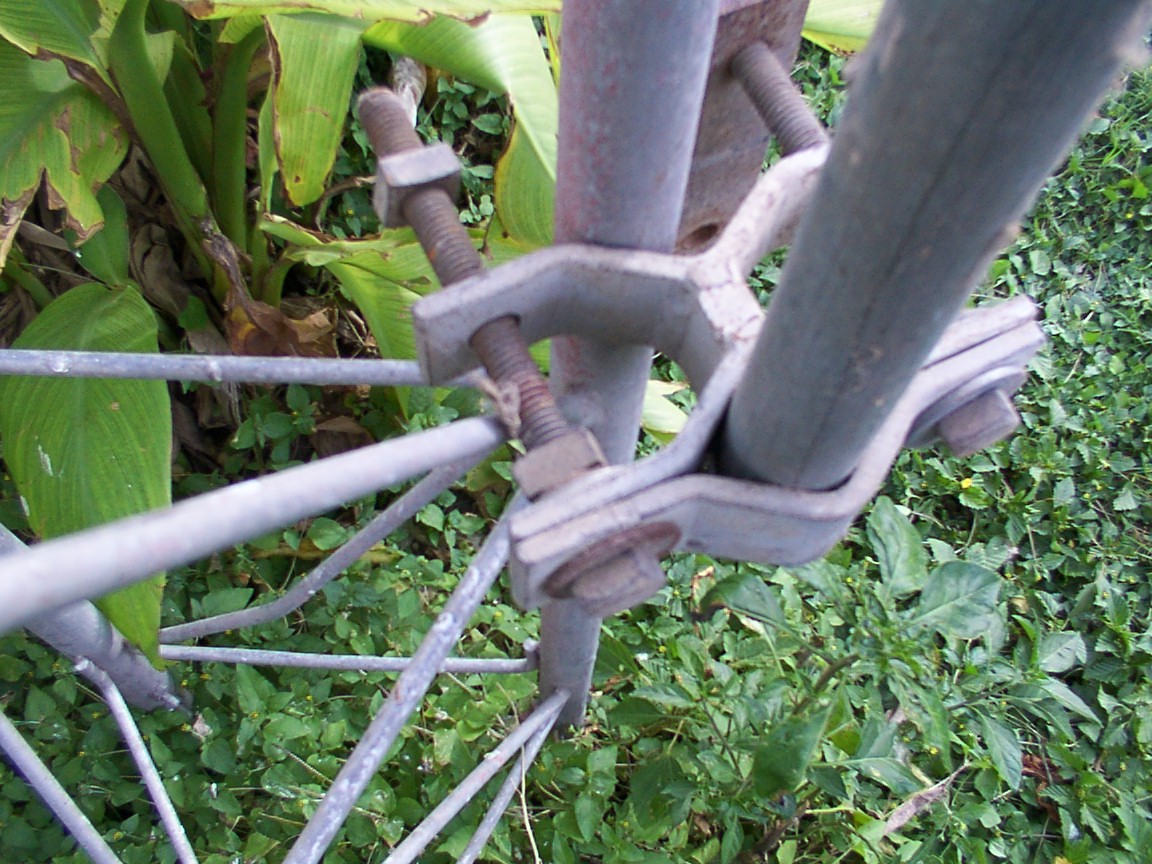
If you loosen the side of the clamp which attaches to the tower sufficiently so that one side will come off (you'll see which side is the right one to take totally off) then the entire gin pole can be wedged into the "V" between the tower braces and the pipe in such a manner that the bolts are around the pipe. Of course you don't want to put a load on the gin pole like this, but it is secure enough so that you can clamp the pole snugly to the tower, then raise it up as high as it will go (until the clamps touch the next higher set of braces), then tighten the clamps somewhat. Don't put a killer torque on these clamps, as you are only lifting 25 pounds or so. It would certainly be better to have the pole slide down a bit than to have one of the clamps' bolts break and drop a tower section, possibly on the guy wires below you that are holding you up! Use common sense here.
Your help must be trustworthy. As these tower sections don't weigh very much, I have even been helped by a female or two in the past, and in fact, you can put up or take down a whole tower by yourself if you don't mind the extra climbing up and down that this would entail. In any event, it probably isn't safe to be up there alone; have someone around please.
One very important thing your help must be good at doing is tying the knot which holds the tower section while you're lifting it. I suggest fixing up the end of your rope by passing it through a 1/2" drive socket (mine is a 1 1/8" socket) and then tying an overhand knot in the rope and cramming that into the business end of the socket, with a couple of inches of rope past the knot hanging out of the socket for safety. If the socket's edges aren't too sharp this will serve for a long time, and the socket's weight will help out a bit when you're lowering the end of the rope from the top of the tower.
With the end of the rope suitably prepared, it is easy to tie it to the tower section (always tie to the middle of a section) with a clove hitch knot (search the internet for this). The size of the socket guarantees that the clove hitch won't come apart. A couple of extra (loose) half hitches couldn't hurt either, although for extra security, I usually request that two clove hitch knots be tied, one on one tower leg and another on the next. Again, tower sections don't weigh very much, but we do want security. One good thing about clove hitch knots is that they don't put sharp bends in the rope which wear it out or weaken it. They are also easy to untie, and the last thing you want while you're up hanging off of a tower is trouble untying a rope.
To keep the tower section from hanging horizontally while you're lifting it, and therefore bouncing off of guy wires and the like and possibly getting caught, twist a loop in the rope near one of the end of the tower section and loop it around one of the legs. As always, don't twist the rope any more than is necessary. You'll see how to go about it. Now when you lift the tower section it will be easier to move around guy wires and the like by manipulating the rope from the top (your job :-).
As far as the mechanics of supporting and guying a tower go, I'd have to suggest that you to go the Rohn web site for the official word. I myself have seen a free-standing 50-foot Rohn 25 tower sitting in 2 feet of concrete in the ground, held up by 3 1/4" nylon ropes tied to this guy's fences! This didn't look safe, but made it through a hurricane somehow. When it came time to take this tower down we just dug around the base a bit, stood on the house, and lowered it down with one or two of the ropes. I sure wasn't going to climb that darned tower! :-)
I put my towers in a hole dug with post-hole diggers a couple of feet deep, just a bit bigger than the tower itself. You want to fill the bottom of the hole with some bricks to hold up the open ends of the pipes away from the dirt, and probably throw some gravel or the like in there too. The goal is to keep the pipes' ends free of dirt and concrete so that any (unlikely) accumulation of water in there can drain out.
The hole in the ground isn't going to hold the tower up anyway; the guy wires are. They should be about every 30 feet (3 sections), at the very top of the section. I have seen towers with much greater spacing and for these frightening beauties I usually add in my own guy wires made out of 1/8" galvanized fence wire. After all, who knows how long some of these towers have been standing? It's scary enough when you're 100 feet up and unhooking the wires from the end of a 30-foot length of tower! I wouldn't push my luck.
The three guying points (where the guy wires go into the ground) need to be fairly solid, although I have seen some pretty flimsy ones hold up. You'll certainly want them out of the way, where they can't be hit by cars or large lawnmowers or the like. I wonder sometimes if one of my cows will panic and run into one and knock my tower over. :-) In any case, I usually dig a cone-shaped hole with post hole diggers, with the large end toward the bottom, and place large pieces of angle iron and/or stainless steel in there, with reinforcing wire of some sort binding everything. Pour the concrete and add enough to stick above the ground a few inches, then taper the top away from the embedded steel so that water doesn't puddle next to it and rust it over time. A failure here could be pretty bad for the health of your tower -- or you, for that matter!
If you're going to take down a tower of unknown quality then you'll first climb it to at least check out the condition. If the outside looks fine then about the only other thing to check is the bolts which join the sections together. If they look bad then replace them as you go up the tower. It's not that difficult, as even a whole tower doesn't weigh that much, and it's not all sitting on each bolt of course. Remove the nut, and then try to punch the bolt out with a center punch or a smaller bolt. If there's a good deal of weight on a particular bolt, then use the "jacker" tool described above to relieve the weight and get the bolt out. Immediately put a new bolt in, of course. I always use friction nuts when replacing these bolts.
1. the tower itself. If it's rusty to the point that it has holes in it, then don't bother with it at all, unless it's to knock it down.
2. the bolts that hold the sections together. The tower is not really that heavy, and you shouldn't have much trouble jacking up the tower at the joints (use a tool like the one I describe and show on my site) and checking both the bolts and the metal of the tower that way. If the tower is fine but the bolts are bad, then replace the bolts as you climb up it the first time.
3. the guy wires. If they're bad then just get some 1/8" galvanized wire from the hardware store (it's cheaper than dying) and make new guy wires for the tower as you climb it, one set at a time. The guy wires don't have to be any more than hand tight, to tell you the truth, and that wire is easy to work with. Get some of the small u-clamps if you buy this wire.
As far as the tower being tilted goes, that's not a very big deal. If everything else is ok I wouldn't worry about it that much. However, if you replace the guy wires, make sure that you leave enough spare wire on the ground ends so that you can straighten the tower (bit by bit) while you're safely on the ground.
Don't take any shortcuts.